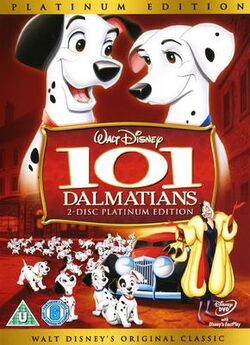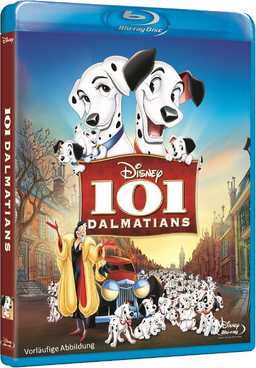(I do not think Percival Faunswater has any Audible Lines, in the Film.) |
(I do not think Percival Faunswater has any Audible Lines, in the Film.) |
||
| Line 46: | Line 46: | ||
*Frederick Worlock as [[Horace Badun]]; Inspector Craven |
*Frederick Worlock as [[Horace Badun]]; Inspector Craven |
||
*[[J. Pat O'Malley]] as [[Jasper Badun]]; [[Colonel]] |
*[[J. Pat O'Malley]] as [[Jasper Badun]]; [[Colonel]] |
||
| − | *Tudor Owen as [[Towser |
+ | *Tudor Owen as [[Towser]] |
*Tom Conway as Quizmaster; [[Collie]] |
*Tom Conway as Quizmaster; [[Collie]] |
||
*George Pelling as [[Danny]] |
*George Pelling as [[Danny]] |
||
Revision as of 01:41, 5 February 2019

Movie poster
One Hundred and One Dalmatians (often abbreviated as 101 Dalmatians) is a 1961 American animated feature produced by Walt Disney and based on the novel The Hundred and One Dalmatians by Dodie Smith. Being 17th in the Walt Disney Animated Classics, the film was originally released to theaters on January 25, 1961, by Buena Vista Distribution.
The film features Rod Taylor as the voice of Pongo, the first of the Dalmatians, and Betty Lou Gerson as the voice of the villainous Cruella de Vil. The plot centers on the fate of the kidnapped puppies of Pongo and Perdita.
Plot

DVD box art
Pongo is a Dalmatian that lives in a London bachelor flat with his owner Roger, a songwriter. Bored with bachelor life, Pongo decides to find a wife for Roger and a mate for himself. While watching various female dog-human pairs out the window, he spots the perfect couple, a woman named Anita and her female Dalmatian, Perdita. He quickly gets Roger out of the house and drags him through the park to arrange a meeting. Pongo accidentally causes both Roger and Anita to fall into a pond, but it works out well as the couple falls in love. Both the human couple and the dog couple marry.
Later, Perdita gives birth to 15 puppies. One almost dies, but Roger is able to revive it by rubbing it in a towel (because of which, they would name the pup, "Lucky"). That same night, they are visited by Cruella de Vil, a wealthy former schoolmate of Anita's. She offers to buy the entire litter of puppies for a large sum, but Roger says they are not selling any of the puppies. Weeks later, she hires Jasper and Horace to steal all of the puppies. When Scotland Yard is unable to prove she stole them or find the puppies, Pongo and Perdita use the "Twilight Bark", normally a canine gossip line, to ask for help from the other dogs in England.
Colonel, an old sheepdog, along with his compatriots Captain, a gray horse, and Sergeant Tibbs, a tabby cat, find the puppies in a place called Hell Hall (a.k.a. The De Vil Place), along with other Dalmatian puppies that Cruella had purchased from various dog stores. Tibbs learns the puppies are going to be made into dog-skin fur coats and the Colonel quickly sends word back to London. Pongo and Perdita immediately leave London to retrieve their puppies. They arrive just as Jasper and Horace are about to kill the puppies. While Perdita attacks Horace and Pongo pulls Jasper's pants down, Colonel and Tibbs guide them from the house.
After a happy reunion with their own puppies, the Pongos realize there are 84 other puppies with them. Horrified at Cruella's plans, they decide to adopt all of the puppies, certain that Roger and Anita would never reject them. The dogs begin making their way back to London, aided by other animals along the way, with Cruella and the Baduns giving chase. In one town, they cover themselves with soot so they appear to be labrador retrievers, then pile inside a moving van going back to London. As the van is leaving, melting snow clears off the soot and Cruella sees them. She follows the van in her car and rams it, but the Baduns, trying to cut off the van from above, end up colliding with her. Both vehicles crash into a deep ravine. Cruella yells in frustration as the van drives away.
Back in London, Roger and Anita are attempting to celebrate Christmas and Roger's first big hit, a song about Cruella, but they miss their canine friends. Suddenly barking is heard outside and after their nanny opens the door, the house is filled with dogs. After wiping away more of the soot, the couple is delighted to realize their companions have returned home. They decide to use the money from the song to buy a large house in the country so they can keep all 101 Dalmatians.
Production
The film is a landmark in animation history for many reasons. It is the first Disney animated film to be set in a contemporary setting. It is also the first Disney film created by a single story man (Bill Peet).
Graphic reproduction

DVD box art (back)
The production of the film also signaled a change in the graphic style of Disney's animation. Ub Iwerks, in charge of special processes at the studio, had been experimenting with Xerox photography to aid in animation. By 1959 he had modified a Xerox camera to transfer drawings by animators directly to cells, eliminating the inking process and preserving the spontaneity of the penciled elements.
The introduction of xerography eased graphic reproduction requirements, but at the price of being unable to deviate from a scratchy outline style because of the new (and time and money saving) technology's limitations. Since the line would not have fit the "round" Disney drawing style used until then (with the exception of Sleeping Beauty), a more graphic, angular style was chosen for this and subsequent films. Rotoscoping, a technique formerly used for tracing live action human characters into animated drawings, became less important.
Another reason for its look was that the animators were used to producing sketchy drawings, as the clean-up was done in the process of transferring the drawings to the cells. With the hand inkers gone, the animation remained as the animators drew it. Later it became common to do clean-up on paper before the animation was copied, and with time and experience, the process improved.
According to Chuck Jones, Disney was able to bring the movie in for about half of what it would have cost if they'd had to animate all the dogs and spots. The studio cut its animation department after the failure of the very expensive Sleeping Beauty, resulting in a reduction of staff from over 500 to less than 100. Walt Disney, who for some years had spent his attention more towards television and his Disneyland amusement park and less on his animated features, disliked this development. The "sketchy" graphic style would remain the norm at Disney for years until the technology improved prior to the release of The Rescuers. In later animated features the Xeroxed lines could be printed in different colors. Unlike previous Walt Disney animated features, One Hundred and One Dalmatians features only three songs, with just one, "Cruella De Vil", playing a big part in the film. Even this song isn't sung in one setting (a scene between Cruella and Anita splits it into two parts). The other two songs are "Kanine Krunchies Jingle" (sung by Lucille Bliss, who voiced Anastasia in Disney's 1950 film Cinderella), and "Dalmatian Plantation" in which only two lines are sung at the film's closure.
To achieve the spotted Dalmatians, the animators used to think of the spot pattern as a constellation. Once they had one "anchor spot", the next was placed in relation to that one spot, and so on and so on until the full pattern was achieved. All total, 101 Dalmatians featured 6,469,952 spots, with Pongo sporting 72 spots, Perdita 68, and each puppy having 32.
Live-action reference
As done with other Disney films, Walt Disney hired an actress to perform live-action scenes as a reference for the animation process. Actress Helene Stanley performed the live-action reference for the character of Anita. She did the same kind of work for the characters of Cinderella and Princess Aurora in Sleeping Beauty.
According to Christopher Finch, author of The Art of Walt Disney:
- "Disney insisted that all scenes involving human characters should be shot first in live-action to determine that they would work before the expensive business of animation was permitted to start. The animators did not like this way of working, feeling it detracted from their ability to create character. [...] [The animators] understood the necessity for this approach and in retrospect acknowledged that Disney had handled things with considerable subtlety."
Voice cast
- Rod Taylor as Pongo
- Cate Bauer as Perdita
- Betty Lou Gerson as Cruella de Vil; Miss Birdwell
- Ben Wright as Roger
- Lisa Davis as Anita
- Martha Wentworth as Nanny; Lucy; Queenie
- Frederick Worlock as Horace Badun; Inspector Craven
- J. Pat O'Malley as Jasper Badun; Colonel
- Tudor Owen as Towser
- Tom Conway as Quizmaster; Collie
- George Pelling as Danny
- Thurl Ravenscroft as Captain
- David Frankham as Sergeant Tibbs: Scottie
- Ramsay Hill as TV Announcer; Labrador
- Queenie Leonard as Princess
- Marjorie Bennett as Duchess
- Barbara Baird as Rolly
- Mickey Maga as Patch
- Sandra Abbott as Penny
- Mimi Gibson as Lucky
- Bill Lee as Roger (singing)
Release
One Hundred and One Dalmatians was first released to theaters on January 25, 1961. After its initial theatrical run, it was re-released to theaters four more times: January 1969, June 1979, December 1985, and July 1991.
One Hundred and One Dalmatians was released on VHS on April 10, 1992 as part of the Walt Disney Classics video series. It was re-released on March 9, 1999 as part of the Walt Disney Masterpiece Collection video series. On December 19, 1999, it received its first DVD release as part of Disney's Limited Issue series. A 2-disc Platinum Edition DVD was released on March 4, 2008.
The film is set to be released on Blu-ray in September 3, 2012.
Reception

Blu-ray cover
One Hundred and One Dalmatians was the tenth highest grossing film of 1961, accruing $6,400,000 in distributors domestic (U.S. and Canada) rentals during its first year of release, and one of the studio's most popular films of the decade. The film was re-issued to theaters in 1969, 1979, 1985, and 1991. The 1991 reissue was the twentieth highest earning film of the year for domestic earnings. It has earned $215,880,014 in worldwide box office earnings during its lengthy history, and currently holds a 97% "fresh" rating from critics and users on Rotten Tomatoes.
Sequels and spin-offs
In the years since the original release of the movie, Disney has taken the property in various directions. The earliest of these endeavors was the live-action remake, 101 Dalmatians. Starring Glenn Close as Cruella De Vil, none of the animals talked in this 1996 edition. This version's success in theaters led to 102 Dalmatians, released on November 22, 2000.
After the first live-action version of the movie, a cartoon called 101 Dalmatians: The Series was launched. The designs of the characters were stylized further, to allow for economic animation, and appeal to the contemporary trends.
Most recently, 101 Dalmatians II: Patch's London Adventure, the official sequel to the original animated film, was released direct-to-video on January 21, 2003.